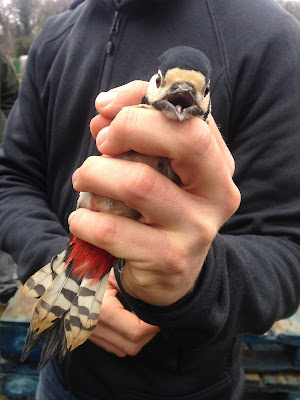The Great Spotted Woodpecker
The Great Spotted woodpecker is a marvellous sight when wandering the countryside or woodlands, and it is relatively common. Here at the UEA, great spotted woodpeckers are common, and can be heard calling from dawn 'til dusk. This bird was first described by Linnaeus in 1758, in his Systema Naturae, as Picus major, however it was transferred to its current genus Dendrocopos by Carl Ludwig Koch in 1816.
Class - Aves
 |
A Great Spotted Woodpecker at UEA - taken February 2016 at a bird-ringing demonstration.
|
Family - Picidae
Genus - Dendrocopos
Species - D. major
"Dendrocopos" is a combination of the Greek words Dendron meaning "tree" and kopos meaning "striking". The word "major" is a Latin term meaning "greater".
Great Spotted woodpeckers are approximately blackbird sized, with a small red crest on the top of their head, and a black "caped" body (the back and wings are black with white specks or stripes, and the underbelly is mostly white with some red colouring near the posterior). They have a wingspan of approximately 34-39cm and can weigh anything between 70-98g. These birds have a "bouncing" flight pattern, meaning that as they fly, they tend to rise and fall through the air as they move forwards. However, being woodpeckers, they spend the majority of their time on the sides of tree trunks or branches. They are notoriously hard to spot, as they move fast and don't hang around for long!
Great Spotted woodpeckers can be seen in many woodlands across the UK and Europe, particularly in deciduous woodlands. They can also be spotted in gardens, parks and coniferous forests, and although not as common in Ireland, a recent increase in the British population is leading to the recolonisation of these birds to the country, as seen since 2007. Genetic data indicates that the birds recolonizing parts of Ireland naturally, are of British descent.
The Great Spotted woodpecker has various adaptations for clinging to tree trunks, and these include the zygodactyl arrangement of the foot, which involves the two back toes and two front toes facing inwards towards each other. These birds also have stiff tail feathers that can be used as a prop to keep the birds upright and balanced on the side of a tree.
Most of us are aware that woodpeckers do as their name suggests; they peck at wood using a hammering motion! And these birds are rather well specialised to do so, as the force with which the bird's beak hits the wood is potentially hugely damaging to the cranium. However, to cope with this huge force on impact, the hinge where the front of the skull joins with the upper mandible is folded inwards and tensioned by a muscle that prepares the cranium for the impact when hammering. The nostrils on the beak of this woodpecker are very small, as to prevent debris from entering the nasal passages and causing damage.
In terms of breeding, Great Spotted woodpeckers are a monogamous species, and they generally nest in holes in trees or specially made nest boxes. These woodpeckers lay between 4-6 eggs, and chicks should fledge the nest within 20-23 days of hatching. The maximum lifespan for a Great Spotted woodpecker is approx. 11 years. They feed mainly on insects and grubs, including beetle larvae, ants and spiders, but they will also eat carrion, suet and may raid the nests of other birds for their chicks or eggs.
Woodpeckers have relatively few predators, however they will be hunted by birds of prey such as sparrowhawks, goshawks and buzzards. They may also act as hosts to numerous parasites, such as the internal parasite Prosthorhynchus transversus (spiny-headed worm), and the tapeworm Anomotaenia brevis.
According to recent data from across the European continent, the total population of Great Spotted woodpeckers appears to be stable and possibly increasing, and the species is thus listed as "least concern" by the IUCN. The increases in the population may be as a result of forest plantation in Europe, more available dead wood and increases in food species. The future of these birds is currently a bright one, however with an ever increasing human population demanding resources from the land, resulting in deforestation and habitat fragmentation, more may need to be done in the future to ensure this beautiful species is protected.


Comments
Post a Comment